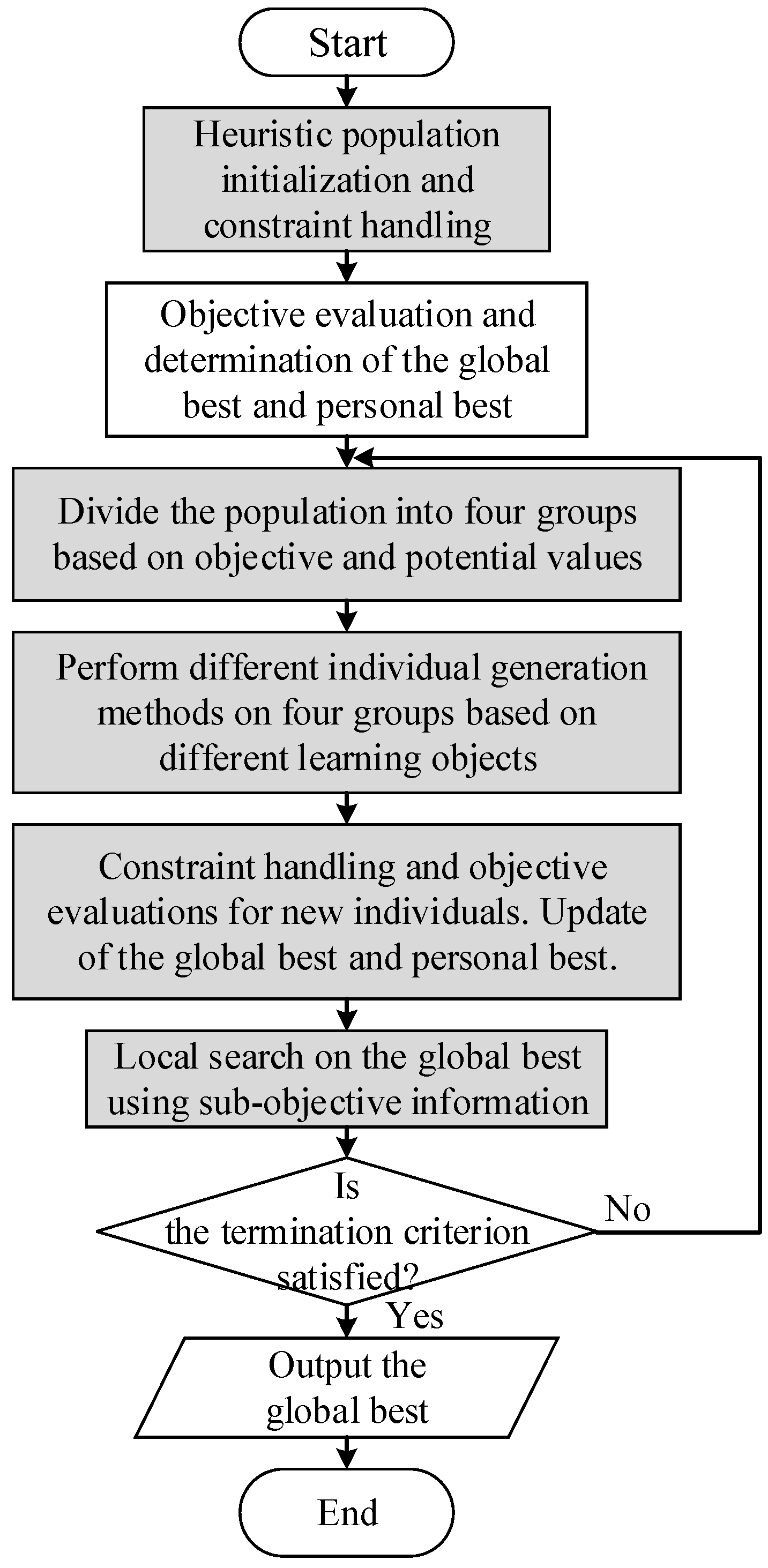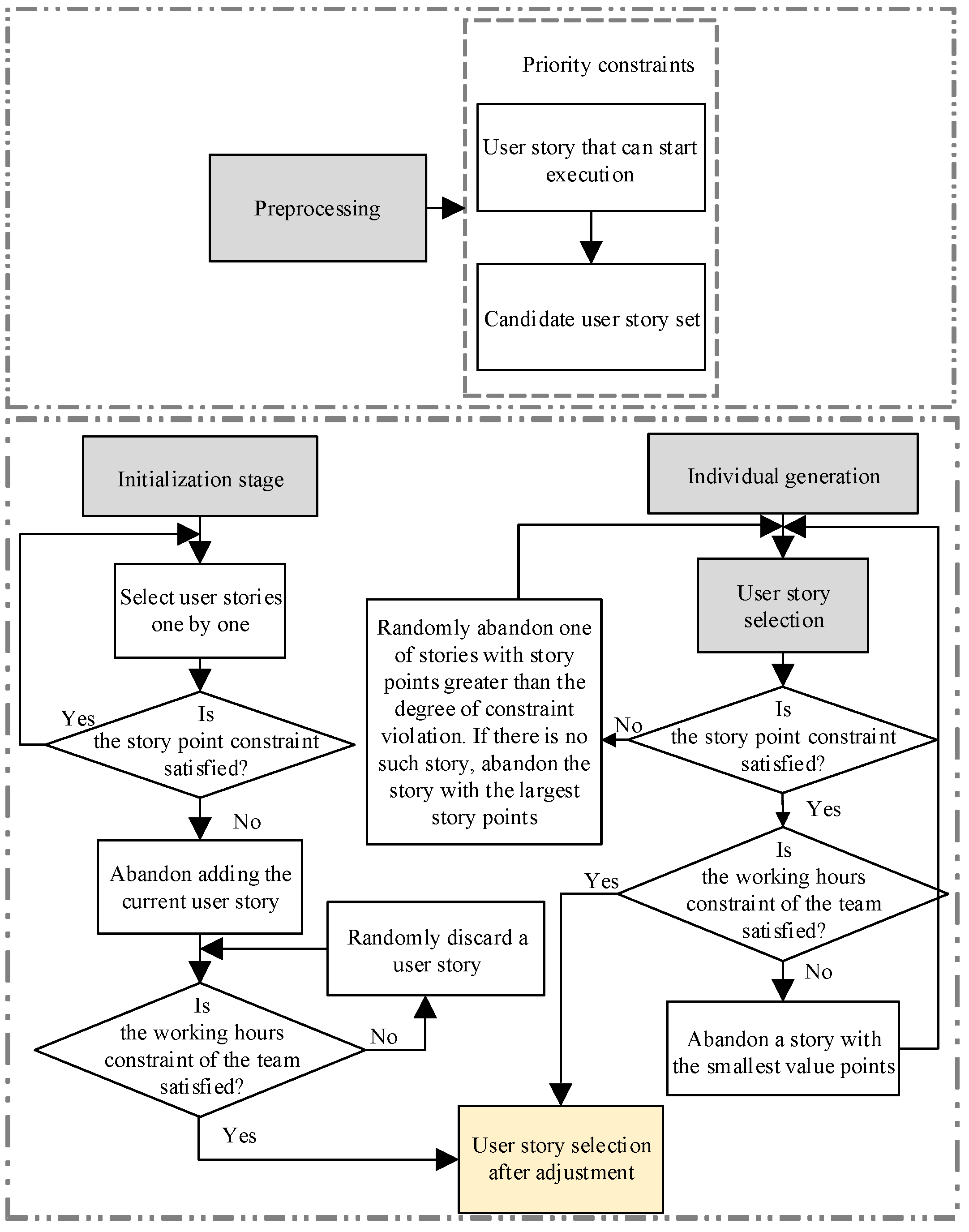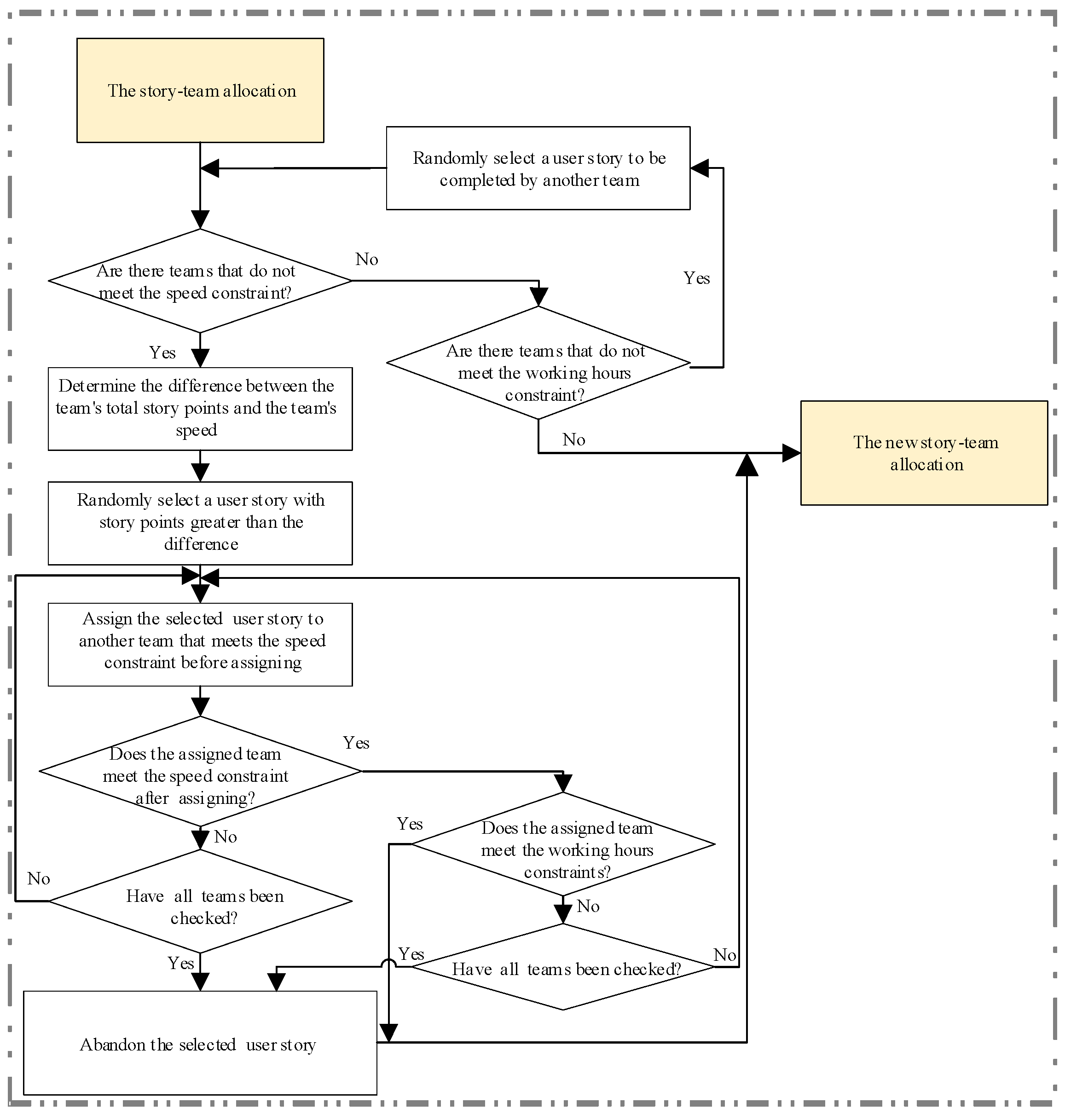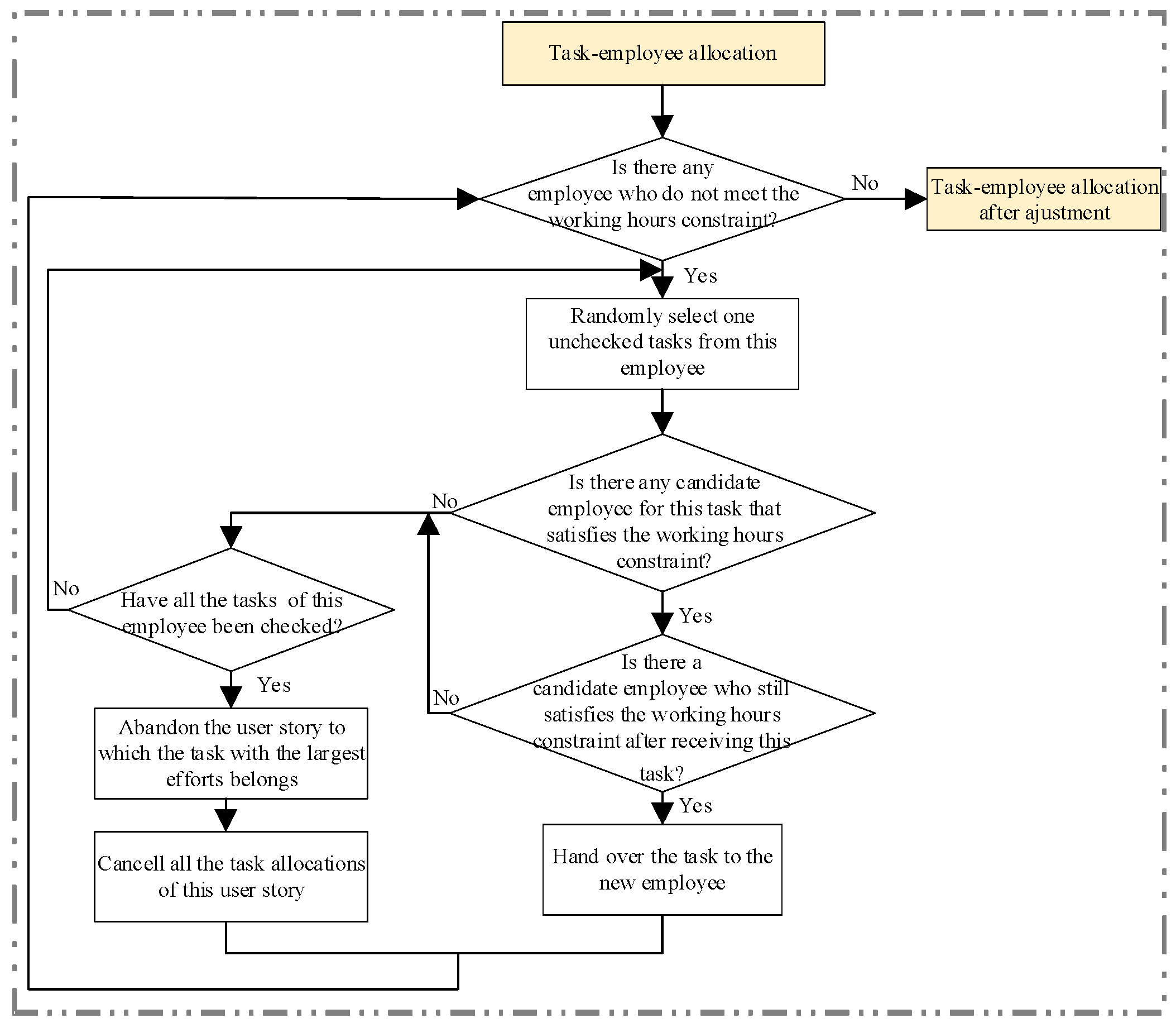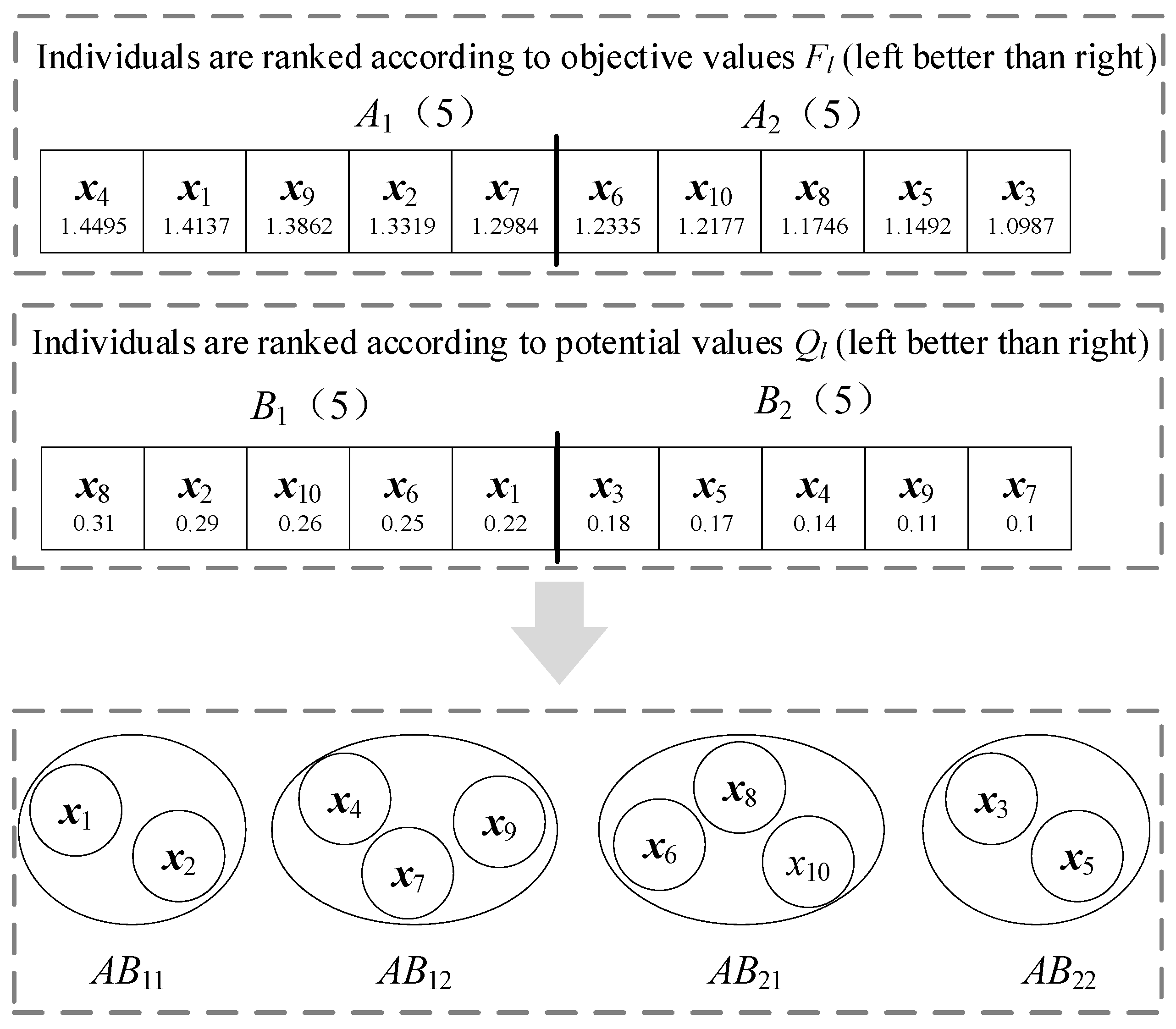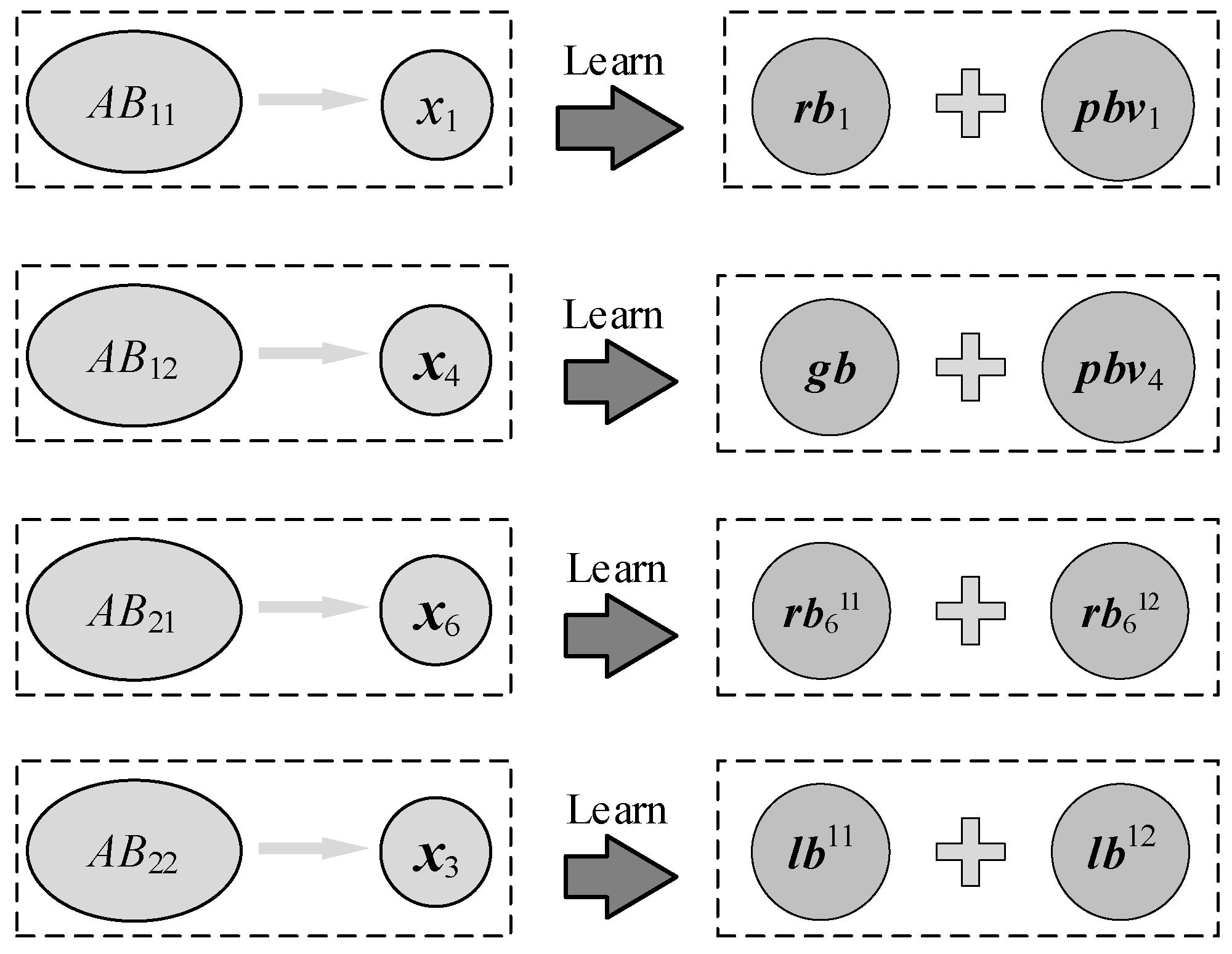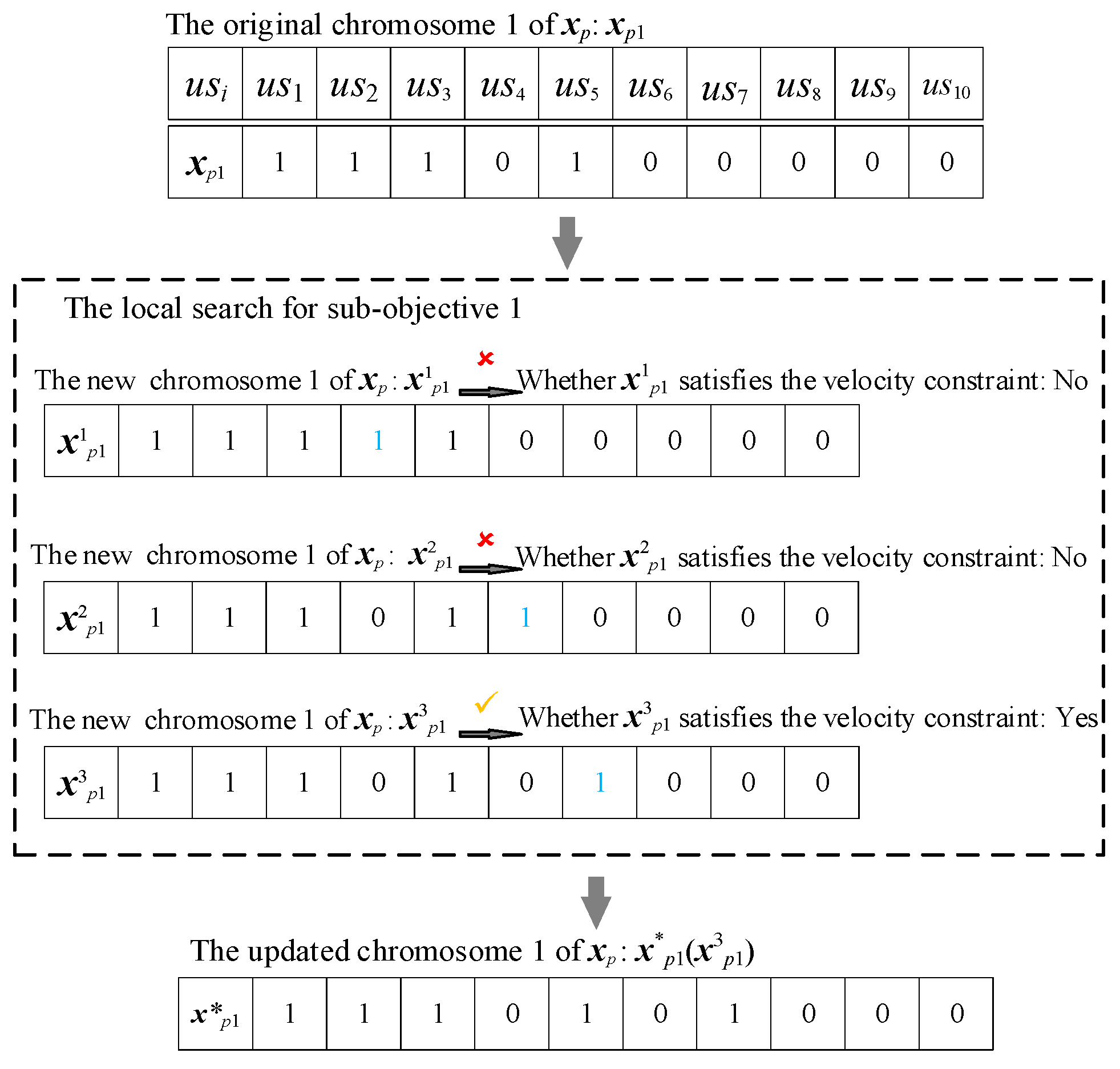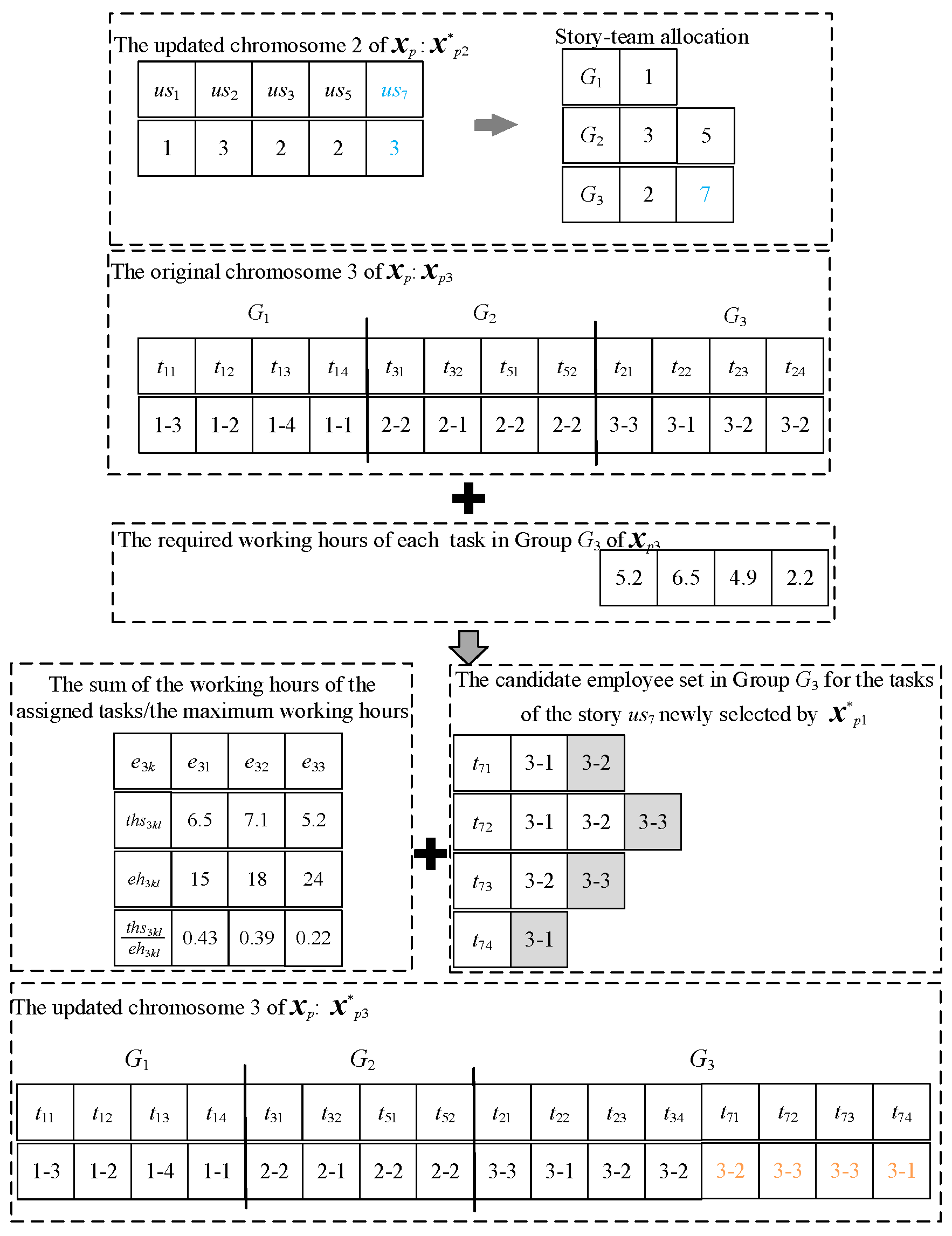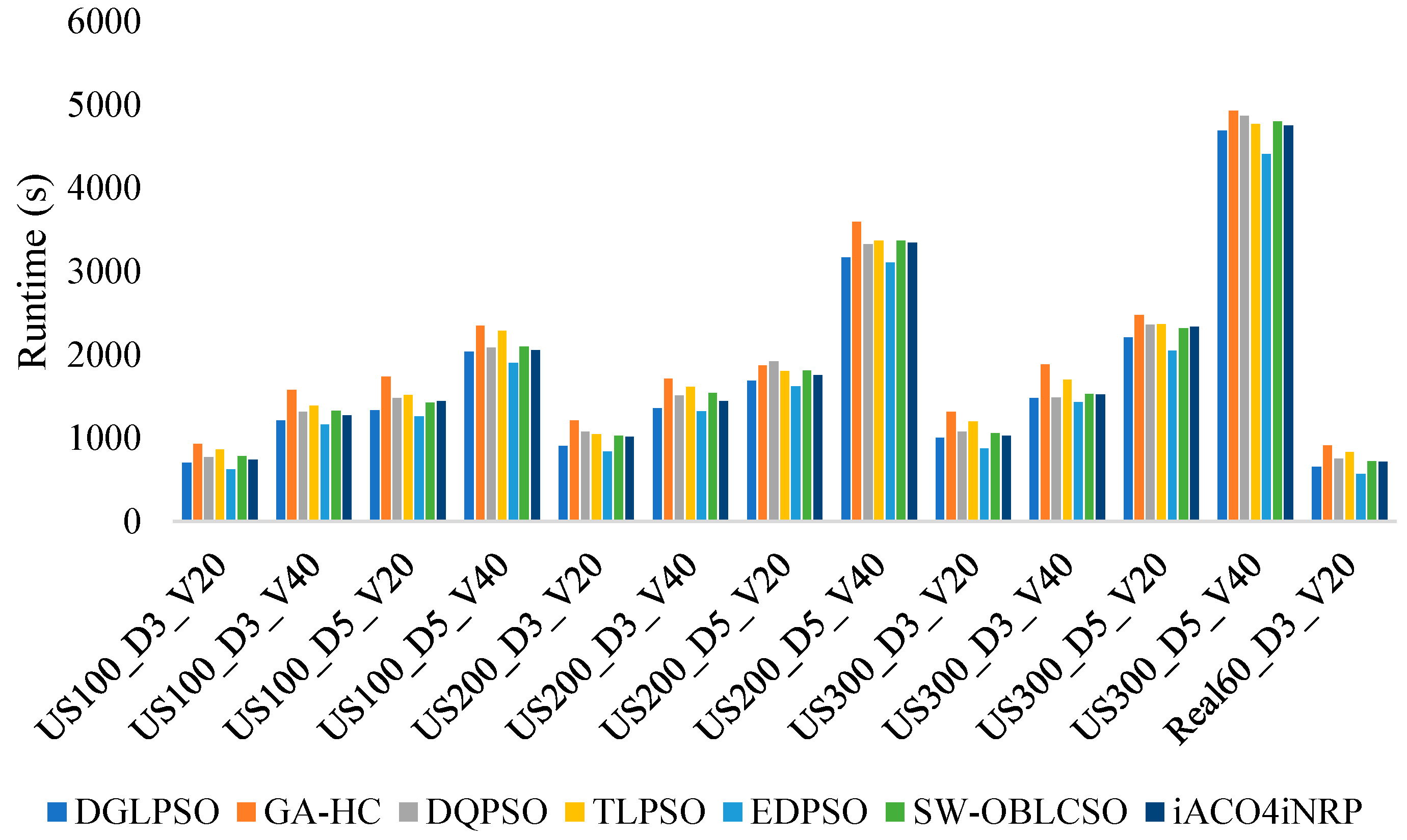1. Introduction
The software industry is one of the important pillar industries for the national economic development. Software projects are generally characterized by long cycles, high complexities, flexible human resources, and high expertise, which increases the risk of project failure. According to a report by Standish Group, the global proportion of projects successfully delivered on time in 2023 is only 34%. One major reason for this is the unreasonable scheduling of tasks and employees by project managers [
1]. Software Project Scheduling (SPS) refers to determining the development sequence of different tasks and allocating employees to each task, on the basis of the estimated task efforts and skill requirements [
2]. SPS aims to optimize the project’s cost, duration, or other performance indicators, satisfying the constraints of human resources, task priorities, and so on. As an important part of software development, SPS directly affects the economic benefits and market competitiveness of enterprises.
Agile software development is a flexible methodology, which adopts “small and skilled” teams and “short time and high frequency” development cycles. It splits the software project through the iterative and incremental approach, making software development more flexible. It is able to timely respond to the requirement changes and dynamically adjust the software development plan. Compared with the traditional waterfall model, agile development addresses close cooperation with customers throughout the development process, providing a faster delivery and a higher project satisfaction. Agile development aligns better with the concept of software project management, and more and more agile software projects have appeared in recent years.
With the surge in user requirements and the ever-changing market environment, software project development has become increasingly complex. Moreover, the tasks in a project might come from different fields and need professional teams. The project development with a single team appears to be limited, making the cross-departmental and cross-team project a common occurrence, especially in agile development. Multi-team Agile Software Project Scheduling (MTASPS) refers to coordinating user stories among different sprints and teams, and assigning various tasks of user stories within teams, considering temporary changes or newly inserted requirements during agile development. Since agile development advocates communication and cooperation between teams, there are more challenges in MTASPS than regular software project scheduling, including competition of shared resources (test environment and cross-domain experts), conflicts between team autonomy and cross-team cooperation, and non-linear growth of communication cost with scale expansion, etc. Such issues will affect various development links like the release plan, sprint plan, and sprint review. By optimizing the user story allocation and resolving the resource conflict, MTASPS plays a vital role in improving the management level and success rate of the agile project. However, to the best of our knowledge, academic research on MTASPS is scarce [
3]. Thus, it is urgent to study the model and algorithm for MTASPS.
SPS has been proven to be an NP-hard problem [
4]. MTASPS can be regarded as an extension of SPS, where dynamic changes in the scheduling environment and allocations of user stories among and within teams need to be considered on the basis of SPS. Therefore, MTASPS is also an NP-hard problem. Core issues in MTASPS, such as resource-constrained balancing and iteration cycle optimization, embody the pursuit of symmetry. Most early studies adopted exact algorithms like dynamic programming or heuristic methods to allocate tasks in software projects. Exact algorithms are capable of finding optimal solutions theoretically but are only applicable to small-scale problems due to limitations in time and space complexity. Heuristic methods construct feasible solutions quickly but cannot guarantee the quality of solutions. With increasing problem scale and complexity of the model, search-based software engineering [
5] has been rapidly developed in recent years. It models complex problems in software engineering as search-based optimization problems, where meta-heuristic algorithms [
6] are employed to search the decision space, further assisting managers in making final decisions. Also, optimization algorithms are widely applied in symmetry-related problems, for instance, in graph theory and pattern recognition.
Particle Swarm Optimization (PSO) is a meta-heuristic algorithm proposed by Kennedy and Eberhart in 1995, which simulates the random search for food by a flock of birds [
7]. PSO has three typical merits: (1) It finds the optimal solution through collaboration and information sharing among individuals in the population. Each individual possesses the abilities of memory, self-learning, and social learning. (2) PSO is easy to implement, with a few parameters and fast convergence. (3) PSO has been widely applied to various scheduling problems, such as berth allocation and quay crane assignment and scheduling problem [
8], job-shop scheduling [
9], network scheduling [
10], and so on. Furthermore, compared to other swarm intelligence-based methods such as Ant Colony Optimization (ACO) and Cuckoo Search (CS), PSO demonstrates distinct advantages for the MTASPS, including superior dynamic adaptability and more efficient constraint handling. When confronted with frequent requirement changes inherent in MTASPS, PSO enables dynamic solution iteration through its real-time particle update mechanism. In contrast, ACO and CS rely heavily on pheromone accumulation or stochastic Lévy flights, respectively, making them highly sensitive to iterations and prone to becoming trapped in a local optimum. Concurrently, PSO can directly encode discrete variables associated with task assignments. While ACO is predominantly suited for path-finding problems, its application to task assignment problems necessitates the additional design of heuristic rules, thereby increasing implementation complexity. Although PSO has achieved some success, its individual updates during the evolutionary process rely too much on the personal best and the global best and fail to fully utilize the effective information of other individuals. This causes the loss of the population diversity, and the algorithm is prone to getting stuck in the local optimum.
Group learning strategy divides the population into several groups, with each group evolving separately to carry out the corresponding search task. These groups interact regularly and cooperate to solve the problem, which is beneficial to improving the search diversity of meta-heuristic algorithms [
11]. Combining the advantages of PSO and group learning, this paper proposes a dual-indicator group learning particle swarm optimization (DGLPSO)-based dynamic periodic scheduling method to solve MTASPS, with the aim of producing the most suitable schedule efficiently in each sprint during the agile software project development.
This work mainly has two contributions: (1) focusing on the three tightly coupled sub-problems, including user story selection, story-team allocation, and task-employee allocation, a multi-team agile software project scheduling model, termed MTASPS, is established, which considers the additions of user stories and uncertainties of employees’ working hours. Moreover, the development experiences and preferences of each team for different types of user stories are also introduced. The model simultaneously maximizes the user story values, employees’ time utilization rates, team efficiency, and team satisfaction under the constraints of team speed and maximum working hours. (2) A DGLPSO-based dynamic periodic scheduling approach is proposed to solve the constructed model MTASPS. First, for the three coupled sub-problems, each individual is encoded by a variable-length chromosome with three layers. Second, we group the population based on dual indicators of objective values and potential values and use different learning objects to guide individuals with distinct characteristics to diversify their learnings. Third, in order to respond to environmental changes and enhance mining abilities, heuristic population initialization and local search strategies are designed using information derived from objectives.
The remainder is organized as follows.
Section 2 discusses the related work.
Section 3 constructs the mathematical model for MTASPS.
Section 4 describes the proposed algorithm, DGLPSO.
Section 5 presents the experimental studies. This work is summarized in
Section 6.
2. Related Work
In this section, the existing studies on the agile software project scheduling (ASPS) and the multi-team task allocation problem are briefly reviewed. We also summarize the existing work on the PSO.
2.1. Models for Agile Software Project Scheduling
As far as we know, only the literature [
12,
13,
14,
15,
16] has studied SPS with the agile development mode. Lucas et al. [
12] proposed an ASPS model to minimize the duration and cost of the agile software project based on task similarities. However, the dynamic periodic scheduling feature of the agile project was not considered. Michael et al. [
13] combined scheduling with Scrum, an agile development framework, to establish a resource-constrained ASPS model, but the dynamic characteristics of requirement changes were not considered. Nigar et al. [
14] constructed an SPS model with a hybrid Scrum framework, where the project duration, cost, stability, and robustness were regarded as the optimization objectives. Nevertheless, its scheduling was essentially based on the waterfall model of software development and did not provide a solution method. Zapotecas et al. [
15] built a scrum-based ASPS model and used the decomposition-based multi-objective evolutionary algorithm MOEA/D to solve it. However, the model directly took the development speed as the project cost and the number of sprints as the duration without considering other factors affecting the cost or duration. In addition, the model did not take dynamic factors into account, like changes in user requirements or employees’ attributes, which made the schedule lack adaptability to environmental changes. Nilay et al. [
16] constructed a multi-objective hybrid model based on the Scrum framework and employed two multi-objective evolutionary algorithms named NSGA-II and SPEA2 for solving it. However, the hybrid model failed to address the allocation of user story-decomposed tasks to employees and ignored dynamic factors like user story insertion or removal. Consequently, the resulting schedule exhibits limited adaptability to real-world dynamics.
In summary, there are still some problems with the existing studies on the ASPS model. First, the characteristic of periodic development in each sprint of the agile project was not reflected in the existing models. Second, during the process of real-world agile development, changes in user requirements and employees’ or user stories’ attributes often occur, while the existing models did not account for such dynamic factors. Third, the existing models only optimized the resource allocation problem, while the actual ASPS involves multiple coupled sub-problems. Last, the existing research has not considered the situation that complex agile software projects need to be completed through multi-team collaboration. In order to overcome the above difficulties, we establish a dynamic periodic multi-team agile software project scheduling model named MTASPS, which focuses on three tightly coupled sub-problems.
2.2. Multi-Team Task Allocation Problem
Mathieu et al. [
17] were the first to introduce the concept of multi-team systems in 2001. So far, a number of scholars have conducted research on the theoretical issues and influence factors in multi-team systems. Carter et al. [
18] discussed the influence of leadership on collaborative innovation in multi-team systems. Davision et al. [
19] investigated the issue of effective collaboration in multi-team systems. Berg et al. [
20] studied the moderating role of emotions in a multi-team system. Matusik et al. [
21] considered the impact of multiple identities of sub-teams on multi-team systems after constructing relational network linkages. Ziegert et al. [
22] explored how to balance the dual identities of the sub-team and the system in a multi-team system and the impact it has on inter-team interactions. Xie et al. [
23] discussed the relationship between management entropy and system network and constructed an evaluation system for multi-team system knowledge. Wu et al. [
24] discussed the impact of diverse knowledge and resources on sub-team productivity.
However, there is limited research on resource scheduling for multi-team systems. Maarten et al. [
25] investigated the impact of cross-sub-team collaboration on sub-team resources and on the performance of the multi-team system. Si et al. [
26] proposed a multi-center collaborative maintenance strategy to optimize the serving route of each group based on dynamic maintenance costs and geographic locations of the centers.
The above studies on multi-team systems or multi-team resource scheduling have only paid attention to the interactions between teams and several influencing factors on system operations. Moreover, only the task assignment problem among teams is considered. Our model MTASPS introduces the development experience and preferences of each team. In addition to two indicators of user story values and employees’ time utilization rates, we also optimize the team efficiency and team satisfaction. Besides assigning the selected user stories to each team, a task-employee allocation is further implemented within the team.
2.3. The PSO Algorithm and the Group Learning Strategy
PSO uses information sharing to evolve the population from disorder to order in the solution space by observing the behavior of bird flocking, and, thus, the optimal solution is obtained. It achieves population evolution by generating better offspring through the initialization and individual evaluation, as well as the speed and position updating. Each individual in the population not only learns from their own “optimal experience” but also learns from the “global optimal experience” of the population so as to adjust direction and speed of the next movement. So far, a lot of studies have been conducted on improving PSO.
In terms of parameter optimization, Eberhart et al. [
27] were the first to present a maximum speed limit to ensure controllable particle trajectories. Cai et al. [
28] designed a dynamic adjustment of the maximum speed to improve the algorithm performance. For the learning factor, Ratnaweera et al. [
29] introduced an adaptive strategy that tuned the learning factor with the evolutionary generations. Jacques et al. [
30] designed a negative learning factor to increase the population diversity. For the inertia weight, Li et al. [
31] proposed a “three-variable iterative” inertia weighting strategy with a multi-information fusion, considering the simultaneous changes in time, particles, and dimensions. Wang et al. [
32] devised a self-adjusting nonlinear strategy for the inertia weight by combining the search levels of different subgroups.
In terms of neighborhood topology, PSO can be classified into global and local models based on whether the particle neighborhood encompasses the whole population. Particles in the global model exchange individuals with other particles in the whole population, resulting in a faster convergence speed, but they are easier to fall into the local optimum. Therefore, a variety of local models have emerged. Some scholars have generated static neighborhood topologies named ring topology, star topology, Von Neumann topology, random topology, etc., depending on particle numbers [
32]. Others have designed dynamic neighborhood topologies. Li et al. [
33] employed a local update strategy with a neighborhood difference mutation to enhance the population diversity. Anh et al. [
34] presented a variable neighborhood search strategy, where particles from different neighborhoods could also exchange information.
In terms of hybrid strategies, many scholars have combined PSO with other algorithms to improve the population diversity and search capability of PSO. Hybrid strategy-based PSO approaches can be categorized into three types: integration with evolutionary algorithms, integration with neural networks, and integration with reinforcement learning. For integration with evolutionary algorithms, Beyene et al. [
35] hybridized PSO with genetic algorithms to dynamically adapt optimization performance, thereby obtaining higher-quality solutions for islanded microgrid problems. For integration with neural networks, Bi et al. [
36] combined PSO with neural networks to propose a new method for predicting the trend of biofuel slagging. And Roy et al. [
37] integrated PSO with artificial neural networks to design a control method for degasser parameters in recirculating aquaculture systems. For integration with reinforcement learning, Zhang et al. [
38] integrated PSO with reinforcement learning, proposing a novel approach to optimize the power allocation strategy for hybrid electric vehicles. These studies have greatly enriched the learning forms of particles in PSO.
Some studies introduced the group learning strategy into the metaheuristic algorithm to divide the population into several groups, which searched the decision space cooperatively. Zou et al. [
39] proposed a dynamic sparse grouping evolutionary algorithm, which dynamically grouped the non-zero decision variables so that the sub-population evolved stably towards a sparser Pareto optimal population. Wichaya et al. [
40] presented a hybrid method combining PSO and the sine–cosine algorithm. The particles were sorted by fitness values from the best to the worst, and then sequentially divided into three groups in the ratios of 20%, 40%, and 40%, respectively. Each group of particles shared the same motion equation. Song et al. [
41] randomly grouped the population into three subgroups of equal size at each generation. Each subgroup adopted different search operators. In this way, different search strategies were performed on each individual with the same probability, which enhanced the population diversity. Hu et al. [
42] grouped the population based on fitness values and particle activity level and improved the original speed and position update methods in PSO. In this way, the grouping mechanism enhanced the efficiency of information exchange between particles.
In this paper, DGLPSO is designed as a dynamic periodic scheduling method, which differs from the previous studies in that: (1) By employing dual indicators of objective values and self-defined potential values, the PSO population is divided into four groups with different characteristics. In contrast, the existing studies commonly grouped the population based on one indicator. (2) For each group, learning objects are chosen based on characteristics of the individuals it contains, and personalized learning is performed, while most previous work focused on devising different search operators in different groups. (3) A dynamic response mechanism and heuristic local search operators are, respectively, designed based on domain knowledge, which aim to increase the search efficiency. In contrast, the existing work underutilized the problem features.
4. A Dynamic Periodic Scheduling Method for MTASPS
In order to solve the formulated model MTASPS, a dynamic periodic scheduling method based on a dual-indicator group learning particle swarm optimization algorithm (DGLPSO) is proposed. Framework of the scheduling method and the procedure of DGLPSO are introduced.
4.1. Framework of the Dynamic Periodic Scheduling
The initial scheduling–periodic rescheduling approach is used to solve the model MTASPS, and the scheduling framework is shown in
Figure 2.
The scheduling has three steps.
Step 1: At the initial time of the project, the project manager specifies key project properties, including user stories to implement, decomposed tasks from user stories, effort estimates, task skill requirements, and employees’ maximum working hours. For example, the project manager may decompose 12 tasks from a user story, like requirements analysis, solution design, UI design, and software testing. After decomposition of user stories, the project manager specifies required skills for each task and estimates effort using techniques such as planning poker or function point analysis. Additionally, the project manager is required to specify team and employee properties, like team development experience and employee maximum working hours. These properties are derived from the project manager’s practical experience, project-specific knowledge, and historical project data. Then, an initial population is generated based on the properties of user stories and employees. The optimal schedule for the first sprint (l = 1), including the user story selection, story-team assignment, and task-employee allocation, is determined by the proposed algorithm DGLPSO. The algorithm optimizes the object while adhering to constraints like each employee must be assigned at least one task, and task skill requirements must be fulfilled.
Step 2: Determine whether the next sprint has been reached. If not, execute the project according to the current schedule. If yes, let l = l + 1, then detect and update the states of user stories and employees at the beginning of the lth sprint through the sprint retrospective and sprint review mechanisms. All the states serve as inputs to DGLPSO. After that, generate a new heuristic initial population based on domain knowledge and obtain the optimal schedule for the sprint by DGLPSO.
Step 3: Step 2 is repeated until the end of the last sprint (l > L).
4.2. The Procedure of DGLPSO
The procedure of DGLPSO is shown in
Figure 3, where the new strategies are marked in gray. The algorithm consists of seven steps: (1) Initialize the population by heuristic information and handle the constraints. (2) Evaluate the objective values and obtain the personal best and the global best. (3) Divide the population into four subgroups based on the objective values and potential values. (4) Update the individuals by selecting different learning objects for different subgroups. (5) Perform constraint handling and objective evaluation on the updated individuals and update the personal and the global best. (6) Conduct local search on the global best by the knowledge derived from the sub-objectives. (7) Check the termination criterion.
4.3. Encoding and Decoding
For the three tightly coupled sub-problems of MTASPS, an encoding method with variable-length three-layer chromosomes is designed.
Figure 4 presents an encoding and decoding illustration.
The project in
Figure 4 has ten initial user stories and three teams. The number of employees in each team is four, two, and three, respectively. Chromosome 1 encodes the user stories by a 0/1 string, with “1” and “0” indicating selection or non-selection of the corresponding story. The length of chromosome 1 is the number of initial user stories
n in the first sprint, and it changes with the customer’s requirements in subsequent sprints (user stories have been completed, added, or cancelled), i.e., the length is not fixed. By decoding, the user stories
us1,
us3,
us4,
us7, and
us9 are selected in the current sprint. Chromosome 2 is the story team encoding, indicating the assignment of the user stories to the teams. The code represents the team number. After decoding, team
G1 will complete the user stories
us1 and
us7,
G2 will complete
us4, and
G3 will complete
us3 and
us9. Each user story is decomposed into several tasks, which are assigned to the employees of the corresponding team, taking into account the skill constraints and the employees’ working time constraints. Chromosome 3 is such a task-employee encoding. Take team
G2 as an example. The user story
us4 is decomposed into four tasks, which are assigned to the two employees in
G2. Among them, employee
e21 performs task
t42, and the remaining tasks
t41,
t43, and
t44 are assigned to employee
e22.
4.4. Heuristic Population Initialization Based on Objective Information
According to the step (1) in
Section 4.2, in the
lth sprint (
), with the aim of improving quality of the initial population and providing the algorithm with a good starting point, heuristic information is extracted from the sub-objective related to each of the three sub-problems. Four selection strategies are designed: value point-based roulette selection, team satisfaction-based roulette selection, team speed-based roulette selection, and working hours-based roulette selection. The greater the value points, the higher the probability of selecting the user story to be executed in the current sprint. The greater a team’s satisfaction or speed, the higher the probability of selecting the team to conduct the current user story. The greater an employee’s maximum working hours in the current sprint, the higher the probability of selecting the employee to execute a task.
Figure 5 shows the heuristic population initialization strategy. For the initial population of size
N,
N/2 individuals are randomly generated in all the three sub-problems to introduce randomness. For the other
N/2 individuals, one of the four roulette selection strategies mentioned above is randomly selected, based on which the corresponding sub-problem is heuristically generated. Meanwhile, the remaining two sub-problems are still randomly initialized.
4.5. Constraint Handling
According to
Section 4.2, new individuals are generated in both steps (1) and (5). To ensure the feasibility of individuals and avoid the reduction in search efficiency and computational resource waste caused by discarding infeasible solutions during the initialization and individual updating, we design some constraint handling methods to process individuals according to the constraints shown in Equations (10)–(17). On one hand, it mitigates the appearances of infeasible solutions. On the other hand, if generated, such infeasible solutions can be transformed into feasible ones while preserving part of their original information.
Constraint handling for user story selection in both the initialization and individual generation is shown in
Figure 6. Pre-processing is conducted at the beginning of each sprint, and the user stories that can start executing constitute the candidate story set based on the story priorities.
In the population initialization, one user story is selected each time and added to the current schedule based on value point-based roulette selection or random selection. This process iterates until the story point constraint defined in Equation (10) is violated, at which point the last added story is removed. Then, check whether the total task efforts decomposed from the selected user stories satisfy the working hours constraint of the entire team (Equation (12)). If yes, the schedule of user story selection is determined. Otherwise, a user story is randomly discarded until Equation (12) is satisfied.
In the individual generation during evolution, first, check the story point constraint (Equation (10)) for the selected user stories of the newly generated individual. If not satisfied, a story with story points larger than the constraint violation degree is randomly discarded, and in the case that there is no such story, the story with the largest story point is discarded until the constraint is satisfied. Second, check whether the total task efforts decomposed from the selected user stories satisfy the working hours constraint of the entire team (Equation (12)). If not satisfied, discard a user story with the smallest value points (retaining the stories with higher value points as much as possible) until it satisfies the constraint.
Figure 7 shows the constraint handling for story-team allocation. For a newly generated individual, first, find out the teams not satisfying the speed constraint (Equation (11)). Determine the difference between the team’s total story points and the team’s speed and randomly select a user story with story points greater than the difference. Assign the selected user story to another team that meets the speed constraint. Next, check whether the assigned team satisfies the working hours constraint (Equation (12)). If yes, the process ends. Otherwise, if none of the teams are able to complete the selected story subject to the constraints, the story is abandoned in the current sprint.
Figure 8 shows the constraint handling for task–employee allocation. After assigning employees to each task, check whether each employee satisfies the working hours constraint (Equation (14)). If there is an employee A not satisfying this constraint, test if assigning a particular task to another employee B would allow employee B to still satisfy the working hours constraint. If so, the task is reassigned to employee B. If not, the story that employee A’s task with the largest efforts belongs to is abandoned.
4.6. The Dual-Indicator Group Learning Strategy
According to steps (3), (4), and (5) in
Section 4.2, individuals are grouped and updated. Most existing population grouping methods classify population into better and worse individuals only based on a single indicator, such as the objective value or degree of improvement [
47]. However, this kind of method ignores the potential for individual evolution and promotion space. To address this issue, a population grouping approach that considers both the objective value and the potential value is proposed. By integrating both the objective value
Fl and evolutionary potential value
Ql (as shown in Equation (18)) of individuals in the current
lth sprint, this approach can not only avoid the mis-discarding of high-potential individuals, thereby maintaining the population diversity, but also implements differentiated learning strategies based on combined characteristics, thereby achieving a dynamic balance between exploitation and exploration.
where the first term of
Ql represents that after executing the schedule at the
lth sprint, the user story points that can still be developed in the remaining time. The second term denotes the value that can be increased in the team efficiency and team satisfaction. The third term means the value that can be increased in the employee’s average time utilization rates. The coefficients
,
, and
make the three weighted terms in the same order of magnitude.
Figure 9 illustrates the dual-indicator group learning strategy. First,
N individuals in the population are, respectively, sorted according to the objective value
Fl and the potential value Q
l, obtaining two sequences of population. For the convenience of understanding,
A1 and
A2, respectively, denote the top
N/2 individuals and the last
N/2 individuals according to
Fl, and
B1 and
B2, respectively, denote those according to
Ql. Selecting
N/2 as the grouping criterion ensures a uniform distribution, thereby mitigating potential biases arising from uneven group sizes and striking a balance between exploration and exploitation in individual evolution. Then, according to the sorting position of each individual on
Fl and
Ql, the whole population is divided into four groups, named
AB11,
AB12,
AB21, and
AB22, respectively.
Take
Figure 10 as an example. There are a total of 10 individuals, so
A1,
A2,
B1, and
B2 each contain 5 individuals. The numerical values below the individual
in each box represent corresponding
Fl or
Ql.
A1 and
A2 are sorted in descending order based on
Fl, and
B1 and
B2 are sorted in descending order according to
Ql. Thus, it can be seen that
A1 includes the
,
,
,
,
,
A2 includes the
,
,
,
,
,
B1 includes the
,
,
,
,
, and
B2 includes the
,
,
,
,
.
is sorted in
A1 based on
Fl and sorted in
B1 based on
Ql; thus, it will be divided into group
AB11. Grouping of other individuals can be obtained in the same way. Ultimately,
AB11 comprises
and
,
AB12 comprises
,
,
AB21 comprises
,
, and
, and
AB22 comprises
and
.
In classical PSO, the current individual learns respectively from the personal best and the global best to generate a new individual. We improve this individual generation method by selecting two appropriate learning objects based on the characteristics of different groups.
Figure 11 illustrates the learning object selection method for different groups. For the individual
in group
AB11, it has not only a good fitness value but also a great improvement potential. Select the personal best value
of
, and any individual
in group
AB11 or
AB12 whose objective value is better than
as the learning object. This method ensures
to learn from the better individual while increasing the population diversity to a certain extent. For the individual
in group
AB12, the personal best value
of
and the current global best
are selected as learning objects. Compared to group
AB11, the individuals in group
AB12 have less improvement room. Thus, the current global best
is used to guide the learning in order to further improve their qualities. Individual
is located in group
AB21, indicating that it has a poor objective value but a lot of room for improvement. Individuals in this group have a high chance of evolving into better solutions. Therefore, individuals in this group are guided to diversify their learning in order to enhance the population diversity. Individuals
and
are, respectively, selected from groups
AB11 and
AB12 uniformly at random as their learning objects, ensuring that the individuals learn from the better individuals while also making full use of the effective information from other individuals. Individual
is located in group
AB22, which has poor objective and potential values. The individuals
and
, with the optimal objective values in groups
AB11 and
AB12, are, respectively, selected as its learning objects.
or
is definitely the current global best
, which ensures that the individual moves in a better direction.
4.7. Objective-Driven Local Search Operators
After updating the individuals, as depicted in step (6) of
Section 4.2, the local search is conducted. To further improve the search accuracy of the algorithm, three enhanced local search operators are designed to mine around the neighborhood of global best based on the information of each sub-objective.
4.7.1. The Greedy Insertion Operator Based on the Team Speed Constraint
For the subproblem of user story selection, a greedy insertion operator based on team speed constraint is designed to maximize the total value points of user stories in the current sprint, as shown in
Figure 12. Chromosome 1 of individual
represents the schedule of user stories in the current sprint, based on which the unselected user story is inserted one by one, and the team speed constraint (Equation (10)) is checked. If it is satisfied, the story is added and the current operation ends. If not, the search continues for the next story that satisfies the speed constraint. If the constraint is still not satisfied after traversing all the unselected stories, the operation ends, and the original chromosome 1 remains unchanged. The updated chromosome 1 (
) of
in the illustration of
Figure 12 newly selects the user story
us7.
4.7.2. Local Search Operators Based on Team Efficiency or Team Satisfaction
For the subproblem of story–team allocation, two local search operators based on team efficiency or team satisfaction are, respectively, designed, as shown in
Figure 13. The newly selected user stories generated by the greedy insertion operator (
Section 4.7.1) are allocated to the team with the lowest development efficiency or team satisfaction to complete, and the new story–team allocation schedule, i.e., the updated chromosome 2 (
), is obtained. In
Figure 13, if the local search operator based on team efficiency is used, the newly selected user story
us7 is assigned to team
G3. If the local search based on team satisfaction is used,
us7 is assigned to team
G1.
4.7.3. The Local Search Operator Based on the Time Utilization Rate
For the subproblem of task–employee allocation within each team, a local search operator based on the time utilization rate is designed to assign the tasks of the newly selected user stories to the candidate employees in the team with low time utilization rates, as in
Figure 14. The time utilization rate
of the
kth employee in the
dth team at the
lth sprint is defined in Equation (19).
Assume that
Figure 13 employs a team-efficiency-based local search operator to assign the newly selected user story
us7 to team
G3. So, it is necessary to assign each task
in
us7 to each employee
in
G3. As shown in
Figure 14, for the originally assigned story
us2 in
G3, its task–employee allocation is kept unchanged. From this, we can obtain the sum of task durations
that each employee
has undertaken at the
lth sprint. Together with the maximum working hours
, we can calculate the current time utilization rate
of employee
. For each task of the newly selected user story
us7, the employee with the lowest time utilization rate is selected from the set of candidate employees who grasp the skill required by the task. For example, task
is completed by employee
,
is completed by employee
, and so on. In this way, an updated chromosome 3 (
) is generated. If the new individual
consisting of
,
, and
, is infeasible, it is adjusted using the constraint handling method of
Section 4.5.
5. Experimental Studies
With the aim of verifying the effectiveness of the proposed strategies and algorithm, we conducted all the experiments in PyCharm 3.9 on a personal computer with an Intel (R) core (TM) i5-7200u CPU @2.50 GHz made in China, and 8 GB Samsung operating memory made in China. Four groups of experiments were performed: (1) Validating the heuristic population initialization strategy. (2) Validating the dual-indicator group learning strategy. (3) Performance verification of the objective-driven local search operators. (4) Validating the overall performance of the DGLPSO-based dynamic periodic scheduling method by comparing it with five state-of-the-art algorithms.
5.1. Instance Generation and Parameter Settings
Across all experiments, the algorithm parameters were set as follows: the population size
N, maximum number of fitness evaluations, and maximum number of iterations were assigned values of 100 [
46], 100,000 [
46], and 1000, respectively. These values represent widely adopted settings in existing literature. Furthermore, other parameters, such as the individual learning factor
and social learning factor
, were both set to 2. This parameter configuration was determined through systematic tuning: each parameter was adjusted within the corresponding range while fixing others constant, with performance observed across experimental process.
With reference to various data of Beta, one of Norway’s largest large-scale agile development projects [
47], and the estimation and plan of agile software development practice by agile expert Mike [
43], 12 MTASPS instances with different sizes were generated. Each instance is named US#1_G#2_V#3, where US#1 denotes the initial number of user stories, G#2 indicates the number of teams, and V#3 denotes the initial speed of each team. Take US100_G3_V20 as an example. It indicates that a project with 100 user stories is completed by three teams, with an initial team speed being 20 story points each. Referring to the literature [
15,
43], the parameter settings (corresponding to
Table 1) of MTASPS instances are shown in
Table 2. In addition, a real instance is gathered from the IT department of a private bank [
16]. The real instance is referred to as a medium-sized problem instance containing 60 user stories and 10 sprints. The instance is named Real60_D3_V20. In the Real60_D3_V20 dataset, the number of user stories, story points, story categories, and number of sprints are provided by the instance. The remaining parameters related to teams and staff members are generated based on [
43,
47]. The population size of the proposed DGLPSO is set to 100, the maximum number of local search iterations is set to 5, and the algorithm terminates after the number of objective evaluations reaches the maximum value of 20,000.
5.2. The Experimental Procedure
In the experiments, each instance includes L sprints (iterations). Eleven algorithms are used to solve the scheduling problems in each sprint, including the proposed algorithm DGLPSO, the five algorithms used to validate effectiveness of the new strategies, and the five comparison algorithms in validating the proposed algorithm. Since the overall performance evaluation of each algorithm across all sprints is different from that at a single scheduling point, the experimental procedures of multi-team agile software project dynamic periodic scheduling are described below.
Step 1: At the beginning of the lth sprint, each of the 11 algorithms runs 20 times, and it terminates until the number of objective evaluations reaches a maximum value of 20,000 in each run. Then, the obtained 220 results are combined, from which the optimal schedule corresponding to the maximum objective value is determined.
Step 2: In the lth sprint, the project is developed according to the selected new optimal schedule. This approach ensures that all the 11 algorithms are compared in the same working environment in each sprint.
Step 3: Determine whether l is equal to the maximum number L. If not, collect the attributes of user stories (including new stories, unfinished stories, etc.), tasks, teams, and employees at the initial time of the (l + 1)th sprint and update the scheduling environment. Then let l = l + 1 and go to step 1. If l is equal to L, then perform step 4.
Step 4: Compare the overall performance of each algorithm across different runs and sprints. As shown in
Figure 15, for the
kth run
of the
qth algorithm
, the optimal objective values in
L sprints are averaged to obtain
. The 20 average values obtained from 20 runs form a vector
. The average and best values of the vector
are recorded as
and
, respectively, which are treated as the overall average and best values of the
qth algorithm. In addition, the Wilcoxon rank sum tests with the significance level of 0.05 are adopted to statistically test the vector
of the proposed algorithm DGLPSO against the vectors (
) of the other 10 algorithms. Experimental results are shown in
Table 3 and
Table 4, respectively, where “+/=/−” denotes the number of instances in which the proposed algorithm is significantly better than/not significantly different from/significantly worse than the corresponding comparison algorithm.
5.3. Validating the New Strategies
This section validates the effectiveness of the proposed heuristic population initialization strategy (
Section 4.4), the dual-indicator group learning strategy (
Section 4.6), and the objective-driven local search operators (
Section 4.7). The comparison results are listed in
Table 3.
5.3.1. Validating the Heuristic Population Initialization Strategy
With the purpose of verifying whether the heuristic population initialization strategy in DGLPSO helps to generate better initial individuals in new sprints and improves the search efficiency of the dynamic scheduling algorithm, it is replaced by a random initialization strategy, obtaining the algorithm named DGLPSO-RI (the DGLPSO algorithm that adopts random initialization). The other parts of DGLPSO-RI are kept unchanged with DGLPSO.
It can be seen from
Table 3 that compared with DGLPSO-RI, DGLPSO finds better values of “Avg.” on 10 of the 13 instances and better values of “Best” on all the 13 instances. The Wilcoxon statistical test result of “9/4/0” demonstrates that DGLPSO significantly outperforms DGLPSO-RI on nine instances, and there is no significant difference between the two algorithms on the remaining four instances, including one small-scale, two medium-scale, and one large-scale instances. According to the objective information of the three subproblems, four kinds of selection strategies are designed for initialization of DGLPSO. It is able to quickly generate initial solutions adapted to the new environment at the beginning of each sprint. Meanwhile, by randomly generating a portion of the population, a better diversity is introduced, which balances the exploring scope and the search efficiency of the algorithm. In contrast, the population of DGLPSO-RI is completely randomly initialized without utilizing any knowledge on the problem, leading to a lower search performance in most problems compared with DGLPSO.
5.3.2. Validating the Dual-Indicator Group Learning Strategy
In order to validate the effectiveness of the dual-indicator population grouping strategy and the way to generate individuals in different groups of DGLPSO, it is, respectively, replaced with the grouping strategy that divides the population by only the objective value Fl and the strategy that only uses the potential value Ql as the grouping criterion, obtaining two algorithms DGLPSO-OVG (the DGLPSO algorithm that adopts the objective value for grouping) and DGLPSO-PVG (the DGLPSO algorithm that adopts the potential value for grouping). Both algorithms divide the population into two groups. The top ( indicates rounding down) individuals form the first subgroup, in which individuals learn from the global best and the personal best, the same as the standard PSO. The last ( indicates rounding up) N/2 individuals constitute the second subgroup, in which individuals learn from the global best and a randomly selected individual with a better ranking number. Meanwhile, the DGLPSO-GL (the DGLPSO algorithm that removes group learning) algorithm is obtained by removing the group learning strategy, which does not group the population, and all individuals learn from the global best and the personal best. The parameter settings, encoding, decoding, and the rest of the three comparison algorithms are the same as DGLPSO.
It can be seen from
Table 3 that compared with DGLPSO-PVG, DGLPSO-OVG, and DGLPSO-GL, DGLPSO achieves better values of “Avg.” and “Best” on all the 13 instances. The Wilcoxon statistical test results are all “11/2/0”, indicating that DGLPSO significantly outperforms the three comparison algorithms on 11 instances, respectively, and there is no significant difference between them in two small-scale or medium-scale instances. The proposed dual-indicator group learning strategy consists of both a dual-indicator-based population grouping method and the use of different learning mechanisms in different groupings. Compared with DGLPSO-PVG and DGLPSO-OVG, which only adopt a single indicator, the dual-indicator grouping makes DGLPSO not only focus on the objective value but also take each individual’s improvement room into account. As a result, the individual measurement is more comprehensive, and the population division is more specified. DGLPSO-GL does not perform the group learning, and the search direction of the population is single, which causes individuals to become assimilated and get trapped in the local optimum. In contrast, the group learning of DGLPSO diversifies the learning objects of individuals. Considering that different grouped individuals own different characteristics on two indicators and undertake different search functions, DGLPSO chooses applicable learning objects for them. In this way, a better guidance is provided to the search direction of each individual, increasing the population diversity and assisting to escape the local optimum.
5.3.3. Validating the Objective-Driven Local Search Operators
To verify the effectiveness of the objective-driven local search operators in DGLPSO, it is removed to obtain the algorithm DGLPSO-LS (the DGLPSO algorithm that removes local search), while other parts are kept unchanged with DGLPSO. It can be seen from
Table 3 that compared with DGLPSO-LS, DGLPSO achieves better values of “Avg.” and “Best” on all the 13 instances. The Wilcoxon statistical test result of “13/0/0” indicates that DGLPSO significantly outperforms DGLPSO-LS on all the instances. These results show that the objective-driven local search operators designed in
Section 4.7 can fully exploit the neighborhood information of the global optimal solution and significantly improve the search accuracy of the algorithm. Thus, it can select more appropriate user stories in each sprint. Meanwhile, the efficiency of story–team allocation and task–employee assignment within the team is also improved.
5.4. Validating the DGLPSO-Based Dynamic Periodic Scheduling Method
As far as we know, there is no multi-team agile software project scheduling model that is the same as this paper and the corresponding solution methods. The distinctions between the proposed model MTASPS and existing software project dynamic scheduling models are detailed in
Section 3.2.4. In order to validate the performance of the proposed algorithm DGLPSO, six representative and recent algorithms are selected for comparisons. Genetic algorithm—Hill climbing (GA-HC) [
48] is a hybrid algorithm combining the genetic algorithm and the hill climbing method, which has been applied to dynamic software project scheduling considering variations of employees’ productivity, a similar problem to our work. As in this paper, GA-HC also deals with multiple objectives through a weighted sum method. GA-HC is chosen to validate whether the proposed algorithm can achieve better accuracy compared to the existing dynamic software project scheduling approach. In addition, since the proposed algorithm is a particle swarm optimization (PSO) algorithm, four improved PSO algorithms that have been applied to the combinatorial optimization problems in recent years are also selected for comparisons. Diversity-preserving Quantum Particle Swarm Optimization (DQPSO) [
49] utilizes the marginal analysis and the clustering method. It incorporates a distance-based diversity maintenance strategy and is applied to the classical 0–1 multidimensional knapsack problem. Three-learning Strategy Particle Swarm Optimization (TLPSO) [
50] contains three hybrid learning strategies and has been validated as efficient in function optimization, as well as several combinatorial optimization problems. Extended Discrete Particle Swarm Optimization (EDPSO) [
51] solves the remanufacturing scheduling problem. It employs a new population updating mechanism, where the learning directions of individuals are guided according to the optimal solution of each sub-objective. Moreover, the crossover and mutation operators are designed to keep the individuals away from the local optimum. Soils and wets—Opposition-based Learning and Competitive Swarm Optimizer (SW-OBLCSO) [
52] is a multi-swarm PSO that adopts the competitive learning and inverse learning, which has been applied to the electric vehicle charging scheduling problem. In addition, through the research, the Next Release Problem (NRP) is very similar to the ASPS problem, so an improved ACO algorithm applied to the NRP problem is selected for comparison. iACO4iNRP [
53] is an interactive ACO algorithm that considers that the user can interact with the algorithm at the priori moments and at in-the-loop moments, which has been effectively applied to the NRP problem. All the six comparison algorithms are encoded and decoded in the same way as described in this paper. The population grouping, the update strategy, and other parameters are the same as their original literature. Each algorithm solves the proposed model following the initial scheduling-dynamic periodic rescheduling approach, as detailed in
Section 4.1. The experimental results of the proposed algorithm and the comparison ones are listed in
Table 4.
It can be seen from
Table 4 that compared with the six comparison algorithms, DGLPSO achieves the optimal values of “Best” on all the instances and the best values of “Avg.” on most of the instances. Wilcoxon statistical test results show that DGLPSO is significantly better than GA-HC, EDPSO, iACO4iNRP, and SW-OBLCSO on all the 13 instances, significantly outperforms DQPSO on ten instances, and significantly outperforms TLPSO on 11 instances. The superior performance of the proposed algorithm is attributed to the combined use of various improved strategies. First, the population initialization strategy provides a good starting point for the algorithm by generating the initial feasible solutions utilizing the features of each sub-objective. Second, the dual-indicator group learning strategy increases the search diversity and reduces the possibility of falling into the local optimum. Last, the objective-driven local search operators mine the neighborhood of the elitist, which further improves the search accuracy of the algorithm. Particularly, DGLPSO performs better than the comparison algorithms in the real-world application (instance Real60_D3_V20). That is to say, in real production, it can assign more valuable user stories and tasks while the team and employees all remain efficient and highly satisfied and, thus, obtain a scheduling solution that is close to the global optimum. This demonstrates the practical utility of the proposed algorithm DGLPSO. In summary, DGLPSO achieves better performance for solving the constructed model MTASPS than the comparison algorithms, and it demonstrates good scalability to problems of different sizes. At the initial stage of each sprint, DGLPSO can automatically provide the project manager with a schedule that behaves well in story value points, team efficiency, team satisfaction, and employees’ time utilization rates, facilitating the manager to make an informed decision.
The runtime of the proposed algorithm was compared against the six algorithms introduced in this section across 13 instances of varying scales.
Figure 16 illustrates the average runtime (in seconds) of each algorithm over all instances. It can be observed that the runtime of the proposed DGLPSO is only marginally slower than EDPSO across all instances. This is attributed to EDPSO’s population update mechanism, which accelerates information propagation and enhances computational efficiency. Furthermore, as evidenced by
Table 4, DGLPSO significantly outperforms EDPSO on all instances in terms of solution quality, indicating that the generated scheduling solutions are superior. Thus, the computational overhead of DGLPSO is justifiable. Additionally, both
Figure 16 and
Table 4 demonstrate that DGLPSO achieves shorter runtimes than all other algorithms across all instances while also delivering significantly better performance metrics on the vast majority of instances. This further validates the efficacy of the proposed DGLPSO.
6. Conclusions
This work aims to study a practical agile software project schedule in which multiple teams cooperate to complete the project. To achieve this, first, we consider the speed, experience, and preferences of each team for developing different types of user stories, which has an effect on the development efficiency and team satisfaction. To capture the dynamic characteristics during the agile project development, we also introduce the insertion of new user stories and the uncertainty of maximum working hours. Then, we construct a multi-team agile software project scheduling model, where, in each sprint, the objectives of user story value, time utilization rates of employees, team efficiency, and team satisfaction are simultaneously optimized subject to the constraints. Next, we propose a DGLPSO-based dynamic periodic scheduling method to solve MTASPS. A three-layer encoding method with variable length is designed for the three tightly coupled subproblems. A dynamic reaction policy is presented to generate an appropriate initial population to adapt to the environmental changes. The population is divided into four groups by dual indicators. In each group, specific learning objects are chosen according to the features of individuals it contains. Heuristic local search operators are also designed.
An experimental study of the proposed strategies and algorithm is performed on 13 instances. Simulation results show that the dynamic reaction policy is capable of guiding the algorithm to better respond to new environments. The dual-indicator-based group learning strategy can help the population to search along different directions so that the population diversity is maintained. The heuristic local search operators further improve the mining ability around the elitists. The proposed algorithm DGLPSO can produce the schedule with higher accuracy in most instances compared to the five state-of-the-art algorithms. Therefore, DGLPSO is more effective in solving the established model MTASPS and exhibits a better scalability to the problem size.
Overall, we capture the uncertainties and dynamic events that might take place during agile project development and consider the user story allocations among multiple sprints and teams. However, several factors remain unaddressed in this research. Specifically, first, the intra-team communication cost and its transmission mechanism during the dynamic adjustments of agile projects, along with the quantitative relationship to collaboration effectiveness, have not been adequately revealed. Second, the influence of leadership on multi-team agile software project scheduling models remains unexplored. Furthermore, how differences in inter-team learning mechanisms impact teams’ adjustment capabilities during agile implementation lacks investigation. These factors not only shape collaborative patterns among multi-teams but also exert profound effects on the overall project through complex interactions. Consequently, in future research, we will conduct multi-case empirical investigations on real-world agile projects. Utilizing methodologies such as in-depth interviews and participant observation, we will systematically examine the relationship between these underexplored factors and the proposed model. This will further validate the mathematical model’s efficacy in practical projects, refine optimization strategies for multi-team collaboration, and advance the research. Moreover, we will further relax the constraints, eliminating restrictions such as single-skill tasks and one-task-per-employee limitations, thereby enhancing the model’s alignment with real-world scenarios.


